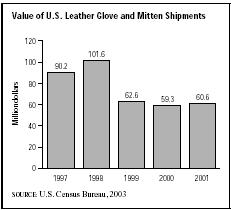SIC 3151
LEATHER GLOVES AND MITTENS
This category includes establishments primarily engaged in the manufacture of dress, semi-dress, and work gloves that are made exclusively of leather or leather with lining of other materials. Excluded are establishments primarily engaged in the manufacture of athletic gloves, classified in SIC 3949: Sporting and Athletic Goods, Not Elsewhere Classified; semi-dress and work gloves made primarily of cloth, classified in SIC 2381: Dress and Work Gloves, Except Knit and All-Leather; and safety gloves, classified in SIC 3842: Orthopedic, Prosthetic, and Surgical Appliances and Supplies.
NAICS Code(s)
315992 (Glove and Mitten Manufacturing)
Historical data shows that the industry has been shrinking in both output and the number of manufacturers over the latter part of the twentieth century and the earlier part of the twenty-first century due to competition from lower priced imports. The U.S. glove industry began about 1760 when Sir William Johnson, founder of Johnstown and Gloversville, New York, brought in a group of glove makers from Perthshire, England, to make deerskin mittens and heavy gloves for nearby farmers. Native Americans had shown Johnson how to use the local barks for dying and tanning. The abundant supply of deer hides and the availability of streams and lakes for tanning the hides and transporting the finished gloves to nearby farm communities helped the industry flourish.
Nineteenth-century inventions that mechanized glove cutting and sewing increased productivity in the industry, but the industry still needed skilled workers. In the 1890s, many glove workers came from Italy. Fulton County, where Johnstown and Gloversville are located, remained the U.S. glove-making center and was home to the now defunct industry association and union headquarters. Through the 1930s, the U.S. Department of Labor noted, men cut most of the materials for gloves in the area's many small factories, and most of the sewing was performed by women. Sewing of the heavier work gloves was done in the factories on heavy duty machines, while work on the dress and semi-dress gloves was often done on a piece-work basis in homes.
After World War II, competition from cheaper labor abroad began to cut into the American market. This trend

continued into the early 2000s. Shipments of leather gloves and mittens declined from $101.6 million in 1998 to just $60.6 million in 2001. One industry leader was Totes-Isotoner Corp., with sales of roughly $300 million in 2001.
This segment of the entire glove and mitten manufacturing industry is relatively small, accounting for only 26 percent of total glove and mitten industry shipments in 2001. Of the more than 100 establishments operating in this industry, less than half primarily deal with leather. The industry as a whole saw employment decline from 6,412 in 1997 to 5,068 in 2000. The leather segment employs roughly one-third of these workers.
Further Reading
U.S. Census Bureau. "Statistics for Industry Groups and Industries: 2000." February 2002. Available from http://www.census.gov/prod/2002pubs/m00as-1.pdf .
——. "Value of Shipments for Product Classes: 2001 and Earlier Years." December 2002. Available from http://www.census.gov/prod/2003pubs/m01as-2.pdf .
Comment about this article, ask questions, or add new information about this topic: